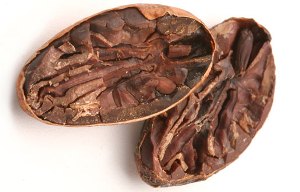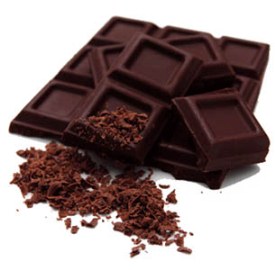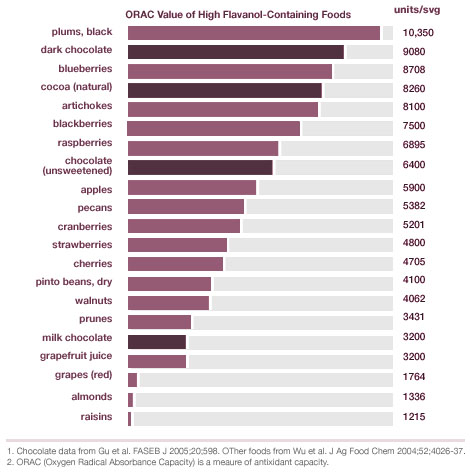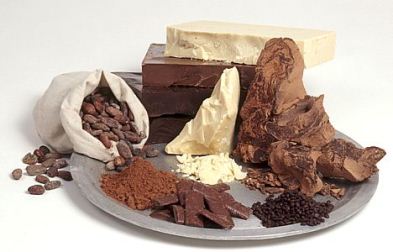
The alleged health benefits of chocolate have circulated the news in recent years, but new research shows that not just any old chocolate will do. A recent Swedish study suggests that chocolate with high cocoa content -- like the kind commonly sold in Europe -- contains the high flavanol content that provides heart benefits.
On the flip side, too much chocolate consumption can be harmful depending on what type it is. The refined sugar and fat content in some conventional chocolates can lead to health problems if consumed excessively, and heavily processed chocolate is not as effective and rich in nutrients as is chocolate in its more natural form.
European chocolate is richer in cocoa content than it is in the U.S. because European standards for chocolate content are higher. The averagechocolate bar in Europe has about 30 percent cocoa content while a U.S. chocolate bar can contain as little as 15 percent, which is important to consider when evaluating which type of chocolate to eat.
Ever wished chocolate grew on trees? Well it does! Cocoa trees grew wild in the Amazon and tropical rain forests of Central and South America for thousands of years – way before it ever reached us in Europe.
Cocoa and Maya civilisation
Cocoa beans were prized by the Maya Indians as far back as 600 AD. They roasted the beans, and added chilli and other spices to make a drink called ‘xocoatl’. It wasn’t much like our drinking chocolate though.
The Mayan drink ‘xocoatl’ means “Bitter Water.”
Mayan Indians lived in what’s now Southern Mexico, the tropical Yucatan Peninsula. At first they harvested cocoa beans from wild trees in the rainforest. Then they started growing their own trees by clearing bits of the forest – which shows how important cocoa was to them.
the rainforest. Then they started growing their own trees by clearing bits of the forest – which shows how important cocoa was to them.
They didn’t only drink the cocoa, they used it as currency too. Here’s an idea of what it was worth:
4 cocoa beans could buy a pumpkin
10 could buy a rabbit
100 could buy a slave
And merchants used cocoa beans to trade for cloth, jade and ceremonial feathers. Just think, if someone hadn’t invented coins and notes, you could have been going to the shops with a pocketful of cocoa beans instead!
Like money and jewellery these days, cocoa beans were valuable and were given as gifts at religious ceremonies and other important occasions.
‘Cocoa fruits were used at festivals for Ek Chuah, the merchant god’.
So how did these ancient people get their cocoa beans from one place to another? With no horses, pack animals or wheeled carts in Central America, instead farmers would travel along the rivers by canoe, or strap big baskets to their backs. Wealthy merchants would employ porters, and could travel further with their cocoa beans – as far as the Aztec kingdom.
Benefit of cocoa chocolate
The most beneficial form of chocolate is the kind that is closest to its raw, natural form, with high cocoa content and no refined sugar. Organic, dark, high-cocoa chocolate made with a little bit of natural sugar is one of the best bets for a sweet, healthy treat.
Flavonoids are naturally occurring compounds that are widely distributed in the plant kingdom, appearing in fruits, vegetables, and plant-derived beverages, such as tea and wine. Flavonoids play an important role in plants, mainly protecting them against external pathogens, ultra-violet light, or heat. The main classes of flavonoids include anthocyanidins, flavones, flavanones, flavonols and flavanols (also known as catechins). Flavonoids are responsible for the red, purple, and blue color of fruits and flowers, and play a role in pollination by attracting insects. They are considered to be the main active component of some medicinal plants due to their well-documented anti-inflammatory properties and their activity as modulators of the immune system, among many other physiological effects. Flavonoids have been claimed to be powerful antioxidants in a number of different biological systems, protecting against damage by free radicals. Most of the flavonoids belong to a group of chemicals called polyphenols, and the antioxidant properties of flavonoids are probably related to their polyphenolic chemical structure.
It is well accepted that a regular intake of fruits and vegetables helps to prevent a number of chronic diseases, especially cancer and cardiovascular diseases. Heart disease and stroke are known to be consequences of atherosclerosis. The oxidative modification of low-density lipoproteins (LDL, the so-called "bad cholesterol") is believed to play a critical role in the development of atherosclerosis. Oxidized LDL activates endothelial cells in blood vessels to produce certain adhesion molecules that lead to the accumulation of white blood cells in the vessel wall. These modified LDL particles are not cleared from the circulation as they should be, but instead migrate to the subendothelial space where they producing so-called "foam cells", filled with LDL, in the vessel wall. This is the initial step in a series of inflammatory events that finally leads to the formation of atherosclerotic plaques. Presumably, this process would be inhibited if the oxidation of LDL could be prevented.
Dietary antioxidants, especially vitamin C, vitamin E, and lipoic acid, and metal chelators have been shown to prevent LDL oxidation and endothelial cell dysfunction. Previous work at the Linus Pauling Institute and in collaboration with investigators at Boston University School of Medicine has demonstrated that vitamin C inhibits LDL oxidation, substantially improves endothelial function and vasodilation in patients with heart disease, and lowers blood pressure in moderately hypertensive patients. Some metal chelators and lipoic acid, but not vitamin C, can inhibit the activity of adhesion molecules on endothelial cells. Therefore, certain antioxidants could lead the way to new strategies to prevent and treat heart disease and stroke.
Many epidemiological studies suggest that flavonoids have some beneficial role in human health. The high flavonoid content of red wine may, in part, account for the compatibility of a high-fat diet with a low incidence of heart disease mortality in some populations that drink wine regularly, a phenomenon called the "French paradox." Cardiovascular benefits of moderate wine consumption have been thought to be due, in part, to the antioxidant and antiplatelet activities of flavonoids and polyphenols. Platelets are substances in blood involved in clotting whose aggregation can cause heart attacks and strokes. Other epidemiological research, such as the Seven Country Study, has found a correlation between high flavonoid content in a diet rich in fruits and vegetables and a lower risk of mortality from coronary heart disease. The Zutphen Study demonstrated that elderly people who drink large amounts of tea, which is a particularly good source of the flavonoids called catechins, have a lower incidence of stroke.
In addition to some fruits, vegetables, and beverages like red wine and tea, chocolate has been identified as a rich source of flavonoids. For a long time, cocoa beans have been recognized as an important source of polyphenols, although these particular polyphenols had not been well characterized or quantified. The medicinal properties of cocoa were well known to the ancient Maya and Azteccivilizations, and cocoa was considered a valuable and are taken up by white blood cells called macrophages, prestigious food of divine origin. Theobroma cacao (the scientific name of the cocoa plant, meaning "food of gods"), prepared as a chocolate beverage, was used to treat a large variety of problems, including gastrointestinal and liver disorders, angina and heart pain, kidney complaints,infection, and inflammation. Aphrodisiac properties and longevity were also attributed to chocolate by the ancient civilizations.
a long time, cocoa beans have been recognized as an important source of polyphenols, although these particular polyphenols had not been well characterized or quantified. The medicinal properties of cocoa were well known to the ancient Maya and Azteccivilizations, and cocoa was considered a valuable and are taken up by white blood cells called macrophages, prestigious food of divine origin. Theobroma cacao (the scientific name of the cocoa plant, meaning "food of gods"), prepared as a chocolate beverage, was used to treat a large variety of problems, including gastrointestinal and liver disorders, angina and heart pain, kidney complaints,infection, and inflammation. Aphrodisiac properties and longevity were also attributed to chocolate by the ancient civilizations.
Cocoa powder and cocoa-derived products, especially dark chocolate, are good sources of flavonoids, mainly epicatechin and its oligomers, called procyanidins. Dark chocolate has the highest total catechin and procyanidin content. The particular procyanidins present in chocolate and related products are not commonly found in such abundance in other plant foods or beverages. Besides their contribution to flavor, procyanidins strongly correlate with the antioxidant activity of chocolate observed in vitro. The latest research suggests that cocoa flavonoids may decrease the oxidation of human plasma compounds (LDL, lipids in general, and physiological plasma antioxidants like vitamin E), modulate platelet activation (an aspirin-like effect), and may positively affect the balance of certain substances involved in hemostatic and inflammatory processes. All these effects of cocoa flavonoids are considered highly relevant to the possible inhibition of atherosclerosis in humans who regularly consume cocoa products.  One important question about chocolate catechins is whether they are effectively absorbed in the body after consuming chocolate. If they are absorbed, then we need to determine the implications that catechin levels in the blood may have for human health. Research carried out at the University of California, Davis, has made important contributions to elucidate these issues. Lucky volunteers were fed different amounts of dark chocolate. Blood samples were obtained from the subjects before chocolate consumption and after two and six hours. Subjects who consumed the highest amounts of dark chocolate had the highest levels of epicatechin in their blood plasma. It was also observed that chocolate consumption significantly increased the total antioxidant capacity of blood plasma and decreased oxidative damage to lipids in the blood, suggesting an in vivo antioxidant role for epicatechin.
One important question about chocolate catechins is whether they are effectively absorbed in the body after consuming chocolate. If they are absorbed, then we need to determine the implications that catechin levels in the blood may have for human health. Research carried out at the University of California, Davis, has made important contributions to elucidate these issues. Lucky volunteers were fed different amounts of dark chocolate. Blood samples were obtained from the subjects before chocolate consumption and after two and six hours. Subjects who consumed the highest amounts of dark chocolate had the highest levels of epicatechin in their blood plasma. It was also observed that chocolate consumption significantly increased the total antioxidant capacity of blood plasma and decreased oxidative damage to lipids in the blood, suggesting an in vivo antioxidant role for epicatechin.
The accumulated evidence suggests that the regular intake of chocolate may help prevent some chronic diseases. It has been suggested that chocolate can be an important source of catechins for young people, who may prefer chocolate to tea, or in countries where tea is not as widely consumed as chocolate. Since chocolate in products is accompanied by fat and sugar, eating too much may cause health problems in susceptible people, although the type of saturated fat (stearic acid) in chocolate does not seem to adversely affect the blood lipid profile. Milk chocolate, on the other hand, contains milk fat and may have an adverse effect. As is the case with red wine, enjoying chocolate in moderation seems to be the key. The good news is that chocolate is not only a delicious food enjoyed by millions, but is also an appealing source of potentially healthful compounds.
![]()
Disclaimer: This website is for information purposes only. By providing the information contained herein we are not diagnosing, treating, curing, mitigating, or preventing any type of disease or medical condition. Before beginning any type of natural, integrative or conventional treatment regime, it is advisible to seek the advice of a licensed healthcare professional.


































